|
Your Challenges –
Our Solutions … Naturally
Terregena
All-Natural Fungal Pesticide Developed for Fly Management in Poultry Production
by
James D. Skinner, Dr. James J. Arends, John R. Struck
The Challenge
The time when flies were deemed only a nuisance to employees or concerns about “speckled” eggs is long past. Today, fly problems, particularly periodic “explosions,” represent a major issue to producers. With urban communities encroaching on farm land, these home owners become active, vocal and litigious when confronted with your fly problem. In addition, recent research has indicated that flies may be the vector for the transmission of serious diseases.
For all of these reasons it is imperative that poultry producers maintain a well planned and executed insect management program (IMP) to guard against fly problems. The challenge is to keep the poultry house in balance by employing proper manure management. Effective management keeps the manure dry to support the ability of the beneficial insects to control the flies along with the use of an effective insecticide that kills flies while leaving the beneficial insects unharmed, is safe for the employees and leaves no chemical residue in the manure that adversely affects its desirability. This article discusses these issues and introduces a new, natural pesticide, balEnceTM. balEnceTM is a fungal product specific for killing flies while being safe for beneficial insects, humans, poultry and the environment.
Fly Life Cycle
The house fly (Musca domestica Linnaeus), shown below, is the principal fly pest.
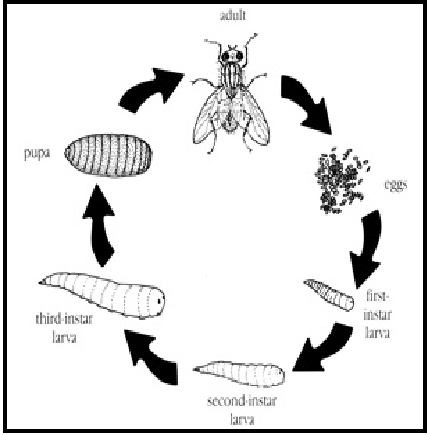
Adult females lay between 300 and 1,200 eggs in manure that is between 60 to 85 percent moisture, wet feed, broken eggs, dead birds or any biological material that is decomposing. The eggs hatch within 12 to 24 hours. Larvae (maggots) need a moist organic environment and will not develop in a dry environment. House flies will develop throughout the year in poultry manure and develop and hatch dependent on the temperature. The warmer the larval environment, the faster the larvae develop to the pupae stage. When temperatures are between 80°F and 90°F, the time needed to go from egg to adult is as little as 10 days while at temperatures between 45°F and 60°F it may take as long as 95 days.
Flies progress through four stages of development – egg, larva, pupa, and adult. Larvae pass through three size changes before crawling to a drier area where they change into a resting stage – pupa – before emerging as adults. The larval and pupal stages may last from 10 to 70 days for house flies depending upon temperature.
Beneficial Insects
Beneficial insects such as Carcinops pumulio, the hister beetle, earwigs and parasitic wasps exist naturally in manure and eat fly eggs and larvae. Earwigs and a number of species of mites also eat fly eggs. The role of these beneficial insects to control flies in a poultry house is of great importance to the fly management program. Carcinops and fly parasites are available from commercial insectaries for release to colonize after clean out.
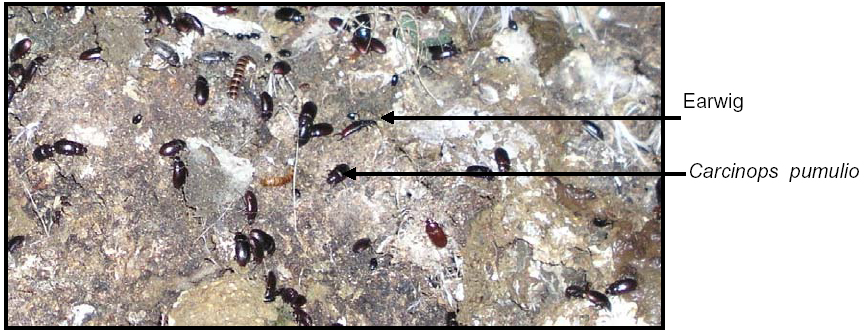
Pictured above are beneficial insects including both an earwig and Carcinops.
These insects are very sensitive to insecticides and the use of any broad spectrum insecticide or larvacide in the house will potentially kill them. Pesticide used at cage level can drift and severely decrease beneficial insect numbers. As their numbers decrease, fly problems increase.
Beneficial insects need dry manure for reproduction while allowing them to be mobile as they search for fly eggs and larvae that serve as one of their primary food sources. Dry manure allows beneficial insect populations to function at their maximum for increased fly control. Manure management and the use of a pesticide that does not harm or kill the beneficial insects are the keys to house fly control.
Manure Management
One of the factors most critical to fly management is maintaining dry manure. Flies multiply rapidly and uncontrollably in a wet environment; beneficial insects that eat fly eggs and larvae live only in dry manure – the drier the manure the smaller the breeding ground for the flies and the larger the breeding area for the beneficial insects that eat the flies. Managing moisture level in manure requires consistent ventilation. Keeping the manure pile conical and dry ensures that only the top few inches are the wet, breeding area for flies. The dry manure immediately below the thin layer of wet manure allows the beneficial insects to breed, eat the fly eggs and larvae and naturally control the fly population.
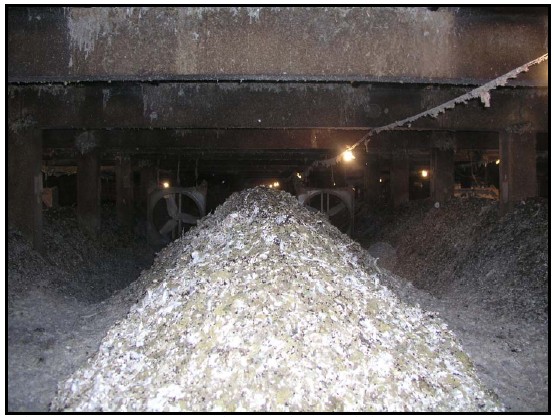
Pictured above is a well managed poultry house with good ventilation and dry manure – the small fly population is under control.
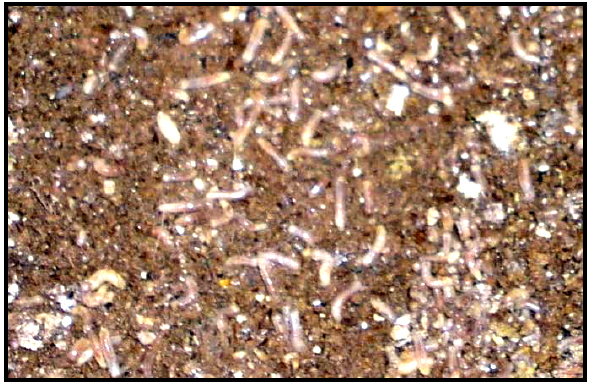
The photograph shows very wet manure with a large number of larvae and no beneficial insects – representing a significant fly problem in the poultry house.
Long term integrated fly management will provide the best control at the least cost. This type of program uses all available options to reduce adult flies and, therefore, fly breeding, while promoting beneficial species. It requires that manure be managed all year and that the control program is functioning year round. It begins with maintaining manure as dry as possible all year and using an insecticide that kills only flies and leaves the beneficial insects unharmed. This promotes beneficial insect populations which, if maintained at a high enough level, maintains the fly population at acceptable levels with little added effort.
Current Treatments
Fly control has typically been based upon the use of chemical sprays and/or larvacides to kill the adult and larval stages of the fly. These insecticides are broad spectrum and kill all insects, including the beneficial species. Choosing this approach should be the last choice. Once this choice is made and applications have started, the producer will be required to continue to treat three to seven times a week until the manure can be cleaned out of the building. This can be a very expensive and labor-intensive program.
Furthermore, flies may develop resistance to pesticides, particularly larvacides. The initial effectiveness of pesticides and larvacides to kill flies may be lost leading to increased fly problems and/or increased use of chemical pesticides.
In addition, there are certain risks for employees associated with the use of chemical pesticides. These risks are greatest during handling and mixing of concentrates prior to application. Spills and splashes during mixing and airborne particulates while loading applicators are the most likely cause resulting dermal, oral and inhalation exposure.
balEnceTM – the Natural Fungus Pesticide
balEnceTM is a new insecticide specific for killing flies. This product was developed by JABB of the Carolinas and was recently approved for sale by the Environmental Protection Agency. balEnceTM is a selective entomopathogen fungus, Beauveria bassiana that infects adult flies but is safe for beneficial species, humans, poultry and the environment. A solution of balEnceTM is sprayed into the house on a regular basis, one to four times per week. Once balEnceTM is released into the manure storage pit area of the house, the spores are picked up by the fly adults where the spores germinate and enter into the flies’ bodies. The fungus grows until it has consumed and killed the fly. This process normally requires three to five days.
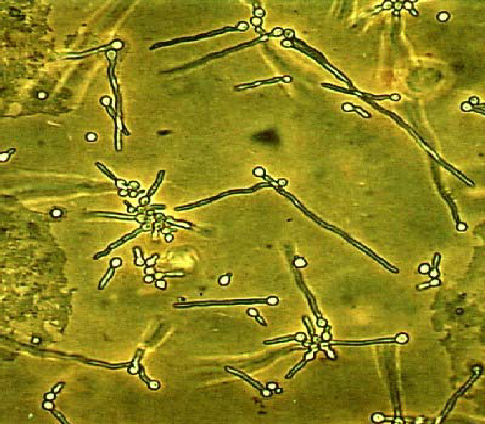
This photograph (above) depicts the Beauveria bassiana spores generating germ tubes that enable the fungus to grow inside the insect and kill it.
The key advantage of using balEnceTM is that it does not harm any of the beneficial species, enabling these species to have their full impact on controlling the fly population and become a significant part of your integrated fly management program. This is the first time that adult fly management has been possible without negatively impacting the natural, beneficial insect, segment of the fly management program.
In a facility where manure has a good cone and ventilation is sufficient to begin or maintain the drying process, applications of balEnceTM two times per week in the pit for four weeks has been shown to be effective in reducing fly numbers to below further treatment threshold levels. If the manure moisture level is high, and uncontrolled fly breeding is taking place, treatment may be needed more frequently until the manure can be dried and the breeding area reduced. Because balEnceTM impacts only flies, the beneficial species continue to increase and as the manure is returned to the proper moisture level, fly populations are under control and the use of balEnceTM is reduced or discontinued – a significant saving when compared to the routine use of chemical sprays.
balEnceTM can be used at any time of the year, regardless of temperature. Thus, balEnceTM will also enable a winter control program to eliminate fly breeding in the cold months, eliminating the spring fly explosion and allowing extra time to dry winter manure to acceptable levels without facing large numbers of flies.
Because balEnceTM is a natural, safe, environmentally friendly and fly specific insecticide, it does not leave a chemical residue in the manure. The manure from houses treated with balEnceTM has sold for a significant premium, which may represent revenue significant enough to pay for the use of balEnceTM in controlling flies.
The development of balEnceTM represents a major breakthrough in fly management. It is an efficacious, cost effective, environmentally safe method of pest control that is not harmful to humans, animals and beneficial insects.
James D. Skinner is President and CEO of Terregena Inc. Contact information: Telephone – 919-789-0306; email – jim@jskinner.com
Dr. James J. Arends is President and CEO of JABB of the Carolinas and the developer of balEnceTM.
John R. Struck is a principal of Terregena and a consultant to the poultry industry.
|

